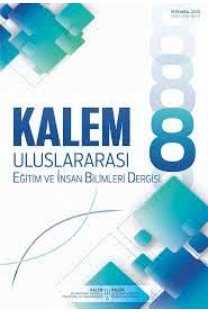Bölüm Seçimine Göre Karanlık Üçlü ve Büyük Beşli Kişilik Özelliklerinin İncelenmesi
An Investigation of the Differences in the Dark Triad and the Big Five Personality Traits Across Majors
___
- Barrick, M. R. and Mount, M. K. (1991). The Big Five personality dimensions and job performance: A meta-analysis. Personnel Psychology, 44(1), 1-26. Doi: 10.1111/j.1744-6570.1991.tb00688.x
- Cleckley, H. M. (1964). The mask of sanity (4th ed.). St. Louis, MO: Mosby.
- Costa, P. T. J., McCrae, R. R. and Holland, J. L. (1984). Personality and vocational interests in an adult sample. Journal of Applied Psychology, 69(3), 390-400. Doi: 10.1037/0021-9010.69.3.390
- Costa, P. T. J. and McCrae, R. R. (1992). The Revised NEO Personality Inventory (NEO PI-R) and NEO Five-Factor Inventory (NEO-FFI) professional manual. Odessa, FL: Psychological Assessment Resources.
- Costa, P. T. J. and McCrae, R. R. (1995). Domains and facets: Hierarchical personality assessment using the Revised NEO Personality Inventory. Journal of Personality Assessment, 64(1), 21-50. Doi: 10.1207/s15327752jpa6401_2
- De Fruyt, F. (1996). Personality and vocational interests: relationship between the Five-Factor model of personality and Holland’s RIASEC typology. Unpublished doctoral dissertation, University of Ghent.
- De Fruyt, F. and Mervielde, I. (1996). Personality and interests as predictors of educational streaming and achievement. European Journal of Personality, 10(5), 405-425. Doi: 10.1002/(SICI)1099-0984(199612)10:5<405::AID-PER255>3.0.CO;2-M
- Furnham, A., Hyde, G. and Trickey, G. (2014). The dark side of career preference: dark side traits, motives and values. Journal of Applied Social Psychology, 44(2), 106-114. Doi:10.1111/jasp.12205
- Gottfredson, G. D., Jones, E. M. and Holland, J. L. (1993). Personality and vocational interests: the relation of Holland’s six interest dimensions to five robust dimensions of personality. Journal of Counseling Psychology, 40(4), 518-524. Doi: 10.1037/0022-0167.40.4.518
- Gunnthorsdottir, A., McCabe, K. and Smith, V. (2002). Using the Machiavellianism instrument to predict trustworthiness in a bargaining game. Journal of Economic Psychology, 23(1), 49-66. Doi: 10.1016/S0167-4870(01)00067-8
- Hare, R. D. (1993). Without conscience: The disturbing world of the psychopaths among us. New York: Pocket Books.
- Holland, J. (1973). Making vocational choices: A theory of careers. Englewood Cliffs, NJ: Prentice-Hall.
- Humburg, M. (2012). The effect of the Big Five personality traits on college major choice: Evidence from a Dutch longitudinal youth cohort study. https://www.semanticscholar.org/paper/The-Effect-of-the-Big-Five-Personality-Traits-on-C Humburg/01b9250d3e7a11c05def28cd6a63ad7d2cde0e99
- İdikut-Özpençe, A. (2017). Economic stability and growth: The case of Turkey. Research in Applied Economics, 9(3), 41-63.
- John, O. P., Donahue, E. M. and Kentle, R. L. (1991). The Big Five Inventory-Versions 4a and 54. Berkeley: University of California, Berkeley, Institute of Personality and Social Research.
- Jonason, P. K., Wee, S., Li, N. P. and Jackson, C. (2014). Occupational niches and the dark triad traits. Personality and Individual Differences, 69, 119-123. Doi: 10.1016/j.paid.2014.05.024
- Jones, D. N. and Paulhus, D. L. (2014). Introducing the Short Dark Triad (SD3): A brief measure of dark personality traits. Assessment, 21(1), 28-41. Doi: 10.1177/1073191113514105
- Kowalski, C. M., Vernon, P. A. and Schermer, J. A. (2017). Vocational interests and dark personality: Are there dark career choices? Personality and Individual Differences, 104, 43-47. Doi: 10.1016/j.paid.2016.07.029
- Mount, M. K., Barrick, M. R. and Stewart, G. L. (1998). Five-factor model of personality and performance in jobs involving interpersonal interactions. Human Performance, 11(2/3), 145-165. Doi: 10.1080/08959285.1998.9668029
- Özsoy, E., Rauthmann, J. F., Jonason, P. K. and Ardıç, K. (2017). Reliability and validity of the Turkish versions of Dark Triad Dirty Dozen (DTDD-T), Short Dark Triad (SD3- T), and Single Item Narcissism Scale (SINS-T). Personality and Individual Differences, 117, 11-14. Doi: 10.1016/j.paid.2017.05.019
- Paulhus, D. L. (2001). Normal narcissism: two minimalist accounts. Psychological Inquiry, 12(4), 228-230.
- Paulhus, D. L. and Williams, K. M. (2002). The dark triad of personality: Narcissism, Machiavellianism, and psychopathy. Journal of Research in Personality, 36(6), 556-563. Doi: 10.1016/S0092-6566(02)00505-6
- Southard, A. C. and Zeigler-Hill, V. (2016). The dark triad traits and fame interest: Do dark personalities desire stardom? Current Psychology, 35(2), 255-267. Doi: 10.1007/s12144-016-9416-4
- Sümer, N., Lajunen, T. and Özkan, T. (2005). Big five personality traits as the distal predictors of road accident involvement. In G. Underwood, (Ed.), Traffic and transport psychology (pp. 215-227). USA: Elsevier Ltd.
- Turkish Statistics Association. (2018). Labor force statistics, October 2017. http://www.tuik.gov.tr/PreHaberBultenleri.do?hbid=16
- Turkish Statistics Association. (2019). Labor force statistics. http://www.tuik.gov.tr/UstMenu.do?metod=temelist
- Vedel, A. (2016). Big five personality group differences across academic majors: A systematic review. Personality and Individual Differences, 92, 1-10. Doi: 10.1016/j.paid.2015.12.011
- Vedel, A. and Thomsen, D. K. (2017). The dark triad across academic majors. Personality and Individual Differences, 116, 86-91. Doi: 10.1016/j.paid.2017.04.030
- Vize, C. E., Lynam, D. R., Collison, K. L. and Miller, J. D. (2018). Differences among dark triad components: A meta-analytic investigation. Personality Disorders: Theory, Research, and Treatment, 9(2), 101-111.
- Wankowski, J. A. (1969, December). Some aspects of success and failure at university. Paper presented at the 4th Annual Conference of the Society for Research into Higher Education, London, UK.
- ISSN: 2146-5606
- Yayın Aralığı: 2
- Başlangıç: 2011
- Yayıncı: Kalem Vakfı Okulları
Fen Bilimleri Öğretmen Adaylarının Bilim ve Bilim İnsanına Yönelik Algıları
Özcan ERKAN AKGÜN, İsmail GÜLEÇ, Yeşim GÜLEÇ-ASLAN, Ayşe Büşra SUBAŞI-YURTÇU
Stresle Başa Çıkmanın Yordayıcısı Olarak Yaşamın Anlamı ve Manevi Deneyim
Zeynep ŞİMŞİR, Erdal HAMARTA, Bülent DİLMAÇ
Yeşim GÜLEÇ-ASLAN, Ayşe Büşra SUBAŞI-YURTÇU, Özcan erkan AKGÜN, smail GÜLEÇ
Seher Merve ERUS, Şerife Gonca ZEREN, Yağmur AMANVERMEZ, Arzu BUYRUK GENÇ
The Relationship between Attachment Styles, Love Types, Emotional Expression and Life Satisfaction
İlköğretimde Cinsiyete Dayalı Mesleki Kalıp Yargılarla Mücadele: Bir Rehberlik Etkinliği Örneği
